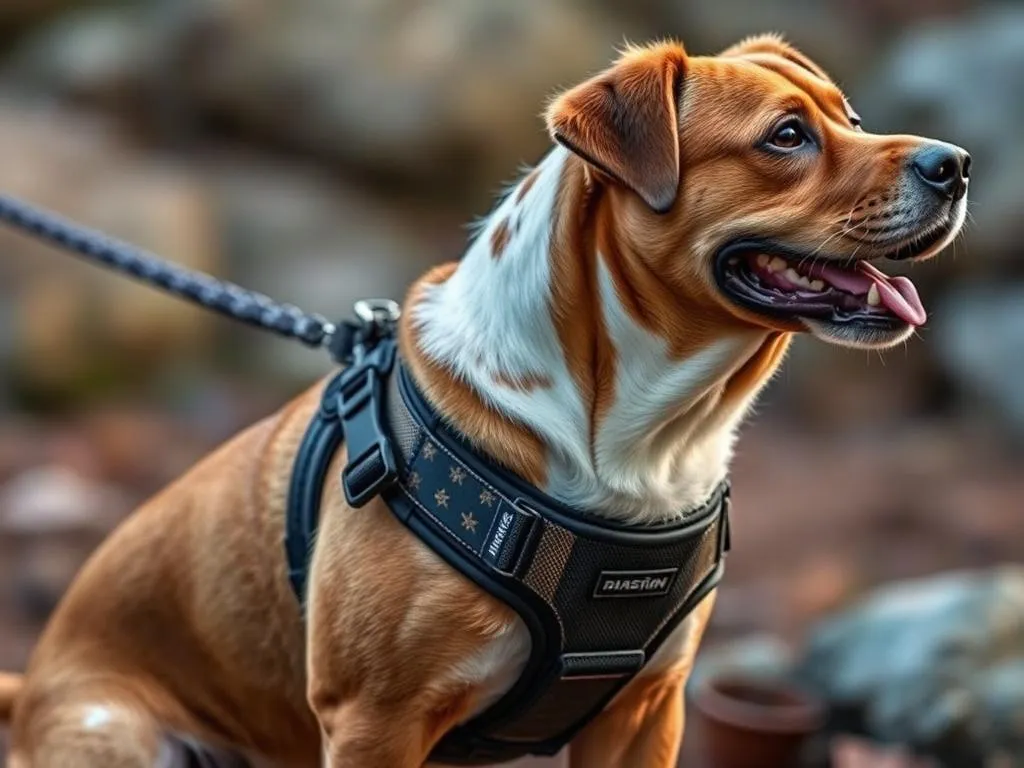
Introduction
When it comes to walking your furry friend, the right gear can make all the difference. One of the most essential tools for dog owners is a dog harness. Unlike collars, which can put undue strain on a dog’s neck, harnesses distribute pressure evenly across a dog’s body, making them a safer and more comfortable option. In this article, we’ll explore the best dog harnesses available today, guiding you through the various types, features, and training tips to help you make an informed choice.
Understanding Dog Harnesses
What is a Dog Harness?
A dog harness is a piece of equipment designed to fit around a dog’s body, typically securing at the chest and back. This design allows for better control during walks and can help reduce pulling behavior. There are several types of harnesses available, including:
- Front-Clip Harnesses: Designed with the leash attachment on the front, these harnesses discourage pulling by turning the dog towards the owner.
- Back-Clip Harnesses: These have leash attachments on the back, making them suitable for well-trained dogs that don’t pull.
- Dual-Clip Harnesses: Offering both front and back attachments, these harnesses provide versatility for different walking situations.
- No-Pull Harnesses: Specifically engineered to prevent dogs from pulling, these harnesses often feature a front leash attachment.
Benefits of Using a Dog Harness
The advantages of using a dog harness over a traditional collar are numerous:
- Improved Control During Walks: Harnesses give owners better control, reducing the likelihood of the dog escaping or pulling away.
- Reduces Strain on the Dog’s Neck: Unlike collars, which can choke a dog when they pull, harnesses distribute pressure across the dog’s chest and back.
- Better for Training and Behavior Modification: Harnesses can be a valuable tool in training, helping to correct unwanted behaviors like pulling or aggressive lunging.
- Increases Safety for the Dog and the Owner: A well-fitted harness can prevent accidents by keeping the dog secure and reducing the risk of injury.
When to Use a Dog Harness
Certain situations call for the use of a harness. If your dog tends to pull on walks, a harness can help manage that behavior. Small breeds, who may be prone to trachea issues, benefit greatly from harnesses. Additionally, senior dogs or those with mobility issues often find harnesses easier and more comfortable than collars.
Key Features to Consider
Material and Durability
The material of a harness is crucial, especially for active dogs. Common materials include:
- Nylon: Lightweight and durable, ideal for everyday use.
- Polyester: Often more resistant to wear and tear.
- Leather: Provides durability and style but can be heavier.
A durable harness can withstand rough handling and the wear that comes from outdoor adventures.
Size and Fit
Measuring your dog for a harness is essential. A harness that is too loose can be uncomfortable and unsafe, while one that is too tight can restrict movement. To ensure a proper fit, measure your dog’s chest and neck, and consult the sizing guide of the harness brand.
Adjustability
Look for adjustable harnesses that feature multiple adjustment points. This allows for a custom fit, ensuring your dog is comfortable regardless of their activity level or body shape.
Safety Features
Safety features to look for include:
- Reflective Elements: Ideal for evening walks to increase visibility.
- Safety Locks and Quick-Release Mechanisms: These features provide peace of mind, ensuring the harness remains securely in place.
Ease of Use
Consider how easy the harness is to put on and take off. This is especially important for older dogs or those with mobility issues. Look for harnesses with simple buckles or step-in designs that reduce hassle.
Types of Dog Harnesses
No-Pull Harnesses
No-pull harnesses are designed to discourage pulling behavior. They typically feature a front leash attachment that redirects the dog towards the owner when they pull. Recommended options include the PetSafe Easy Walk Harness and the Rabbitgoo No-Pull Harness, both known for their effectiveness in training.
Front-Clip Harnesses
Front-clip harnesses help reduce pulling by giving owners more control over their dog’s movement. They are particularly effective for dogs that tend to lunge or dart. Options like the Ruffwear Front Range Harness and the Kurgo Tru-Fit Smart Harness are excellent choices.
Back-Clip Harnesses
Back-clip harnesses are ideal for well-trained dogs that don’t pull. They are easy to use and comfortable for the dog. Popular choices include the Blue-9 Balance Harness and the Puppia Soft Dog Harness.
Service and Support Harnesses
These specialized harnesses are designed for service dogs and provide support for various tasks. They often include features such as padded handles and storage for supplies. Look for brands like Ruffwear and EzyDog for quality options.
Adventure and Sport Harnesses
For active dogs that love hiking, running, or other outdoor activities, adventure harnesses are essential. These harnesses are designed for durability and comfort during long trips. Consider the Ruffwear Web Master Harness or the Kurgo Journey Dog Harness for your next adventure.
Top Recommendations for the Best Dog Harnesses
Best Overall Dog Harness
Product Name: Ruffwear Front Range Harness
Features: Padded chest and belly panel, multiple adjustment points, durable material.
Pros: Comfortable for long wear, versatile for various activities.
Cons: Higher price point.
Price Range: $40 – $50.
Best Budget Dog Harness
Product Name: PetSafe Easy Walk Harness
Features: Simple design, front clip, and adjustable straps.
Pros: Affordable, effective at reducing pulling.
Cons: May not be suitable for larger breeds.
Price Range: $20 – $30.
Best for Large Dogs
Product Name: Kurgo Tru-Fit Smart Harness
Features: Padded, crash-tested design, adjustable straps.
Pros: Durable and safe for large breeds, easy to use.
Cons: Can be bulky for smaller dogs.
Price Range: $30 – $50.
Best for Small Dogs
Product Name: Puppia Soft Dog Harness
Features: Soft fabric, adjustable chest belt.
Pros: Comfortable for small dogs, stylish options available.
Cons: Not suitable for dogs that pull excessively.
Price Range: $20 – $30.
Best for Puppies
Product Name: PetSafe Easy Walk Puppy Harness
Features: Adjustable fit, lightweight material.
Pros: Great for training, gentle on the neck.
Cons: Limited sizing options as the puppy grows.
Price Range: $25 – $35.
Best for Active Dogs
Product Name: Ruffwear Web Master Harness
Features: Secure fit, padded handle for lifting.
Pros: Ideal for hiking and adventurous activities.
Cons: More expensive than standard harnesses.
Price Range: $60 – $80.
How to Train Your Dog to Use a Harness
Introduction to Harness Training
Acclimating your dog to a harness is vital for a positive experience. Training should focus on making the harness feel comfortable and familiar.
Step-by-Step Guide to Training
- Introduce the Harness: Allow your dog to sniff and explore the harness. Reward them with treats to create positive associations.
- Practice Putting It On: Gradually put the harness on your dog while rewarding them. Keep the first few sessions short and positive.
- Short Training Sessions: Once your dog is comfortable wearing the harness, take them on short walks to adapt to the feeling of being attached.
- Positive Reinforcement: Use treats and praise to encourage your dog during walks while wearing the harness.
Common Challenges and Solutions
- Pulling or Resistance: If your dog resists wearing the harness, go back to step one. Make the process more positive with treats and patience.
- Discomfort: Ensure the harness fits well. Adjust straps and check for rubbing or chafing.
Frequently Asked Questions (FAQs)
How do I choose the right size harness for my dog?
Measure your dog’s neck and chest, and refer to the sizing chart of the harness brand. A well-fitted harness should allow for two fingers to fit between the harness and the dog’s body.
Can my dog wear a harness all the time?
While harnesses are generally safe for prolonged use, it’s recommended to remove them during playtime or when your dog is at home to prevent discomfort.
What should I do if my dog hates the harness?
Take it slow. Focus on positive reinforcement and reward your dog each time they interact with the harness. Patience is key!
How do I clean and maintain a dog harness?
Most harnesses are machine washable, but always check the care instructions. Regularly inspect the harness for wear and tear to ensure your dog’s safety.
Are there any safety concerns with dog harnesses?
While harnesses are generally safe, they must be fitted properly. An ill-fitting harness can cause discomfort or injury, so always ensure it is snug but not restrictive.
Conclusion
Choosing the right harness for your dog is essential for their safety and comfort during walks and activities. With various options available, it’s important to consider your dog’s specific needs and behavior. Whether you’re looking for the best dog harnesses for pulling, training, or adventure, this guide has provided comprehensive insights to help you make an informed choice. Happy walking!









